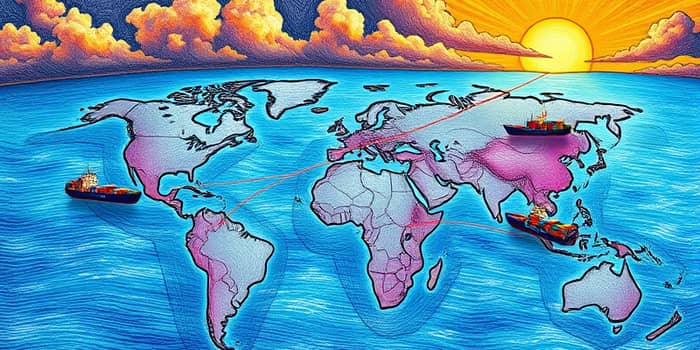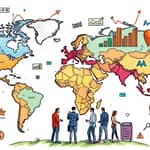
2024 marked a momentous high of record $33 trillion in trade flows, yet the horizon for 2025 appears shadowed by policy shifts and market tensions. Business leaders, policymakers, and communities worldwide face an intricate web of international measures that could reshape economies and livelihoods. Understanding these developments is vital for navigating challenges and seizing opportunities amid global volatility.
This article delves into the latest forecasts, dissecting how tariffs, protectionism, and geopolitical rifts are redefining trade dynamics. Through data analysis, regional insights, and strategic perspectives, readers will gain a comprehensive view of the forces at play and practical guidance for adaptation.
Global trade reached unparalleled heights in 2024, but the momentum is faltering. A modest 0.2% decline in merchandise trade volume is projected for 2025, with North America’s exports bearing the brunt of a forecasted 12.6% drop. Services trade, once a resilient pillar, sees its growth outlook trimmed to 4.0%, signaling headwinds across multiple sectors.
In a more pessimistic scenario of escalating barriers, global merchandise trade could contract by as much as 1.5%. Such outcomes underscore the deepening uncertainty for global markets, sparking concerns over investment, employment, and consumer prices.
Protectionist impulses have surged, as nations enact and debate measures aimed at safeguarding domestic industries. The United States, for instance, has floated tariffs of 20% to 50% on EU imports, while Mexico narrowly escaped a proposed 25% hike on its US-bound exports. Agriculture, manufacturing, and technology sectors are on high alert as policy volatility intensifies.
Tariff escalation—where duties climb on intermediate and finished goods—fosters significant barriers to value-added exports, hampering growth prospects for lower-income nations and locking economies into raw commodity roles.
Frequent tariff announcements, renegotiations, and postponements have injected a potent mix of optimism and dread into corporate boardrooms. Companies delay long-term projects, reassess supply chains, and weigh the merits of onshoring versus diversification. The Brookings-FT trade uncertainty indexes illustrate that any open economy is susceptible to confidence shocks when policy whiplash becomes the norm.
As firms confront this fluid environment, they adopt a range of strategic responses:
These moves reveal an urgent need for coordinated action among governments and industry bodies to preserve the predictability essential for sustained investment.
While advanced economies wrestle with policy debates, developing countries face tougher odds. Least-developed nations, in particular, risk falling further behind as their exports encounter mounting obstacles. Steel tariffs, agricultural levies, and nontariff barriers combine to constrict market access and depress growth.
North America, despite its economic heft, is not immune. A projected 12.6% export downturn reflects both domestic tariff activism and global demand softening. Meanwhile, Africa, Southeast Asia, and Latin America are scrambling to diversify export portfolios and negotiate regionally focused trade pacts as global frameworks show signs of strain.
Experts warn that without policy stability and market openness, vulnerable populations could face heightened poverty, food insecurity, and unemployment. This scenario underscores the resilient and adaptive supply chains required to sustain living standards and foster inclusive growth.
Despite challenges, the current climate also presents a transformative opportunity for collective growth. Stakeholders can leverage the following approaches to chart a more stable course:
Balancing national security concerns with benefits of openness is delicate but necessary. Policymakers must weigh short-term political gains against long-term economic resilience. Successful examples include streamlined customs processes, mutual recognition of standards, and targeted support for emerging industries.
By emphasizing transparency and dialogue, governments can mitigate the worst effects of escalating trade tensions and tariffs while preserving the engine of commerce that lifts billions out of poverty.
The 2025 trade outlook paints a mixed picture: minor declines in volume may mask deeper disruptions under the surface. Yet, history shows that periods of upheaval can also spark innovation, alternative alliances, and smarter policy frameworks. Stakeholders who embrace adaptability, data-driven decision-making, and collaborative diplomacy will be best positioned to thrive.
As the world grapples with balancing national and global interests, business leaders and governments alike must remember that trade is more than flows of goods—it is the lifeblood of shared prosperity. The choices made today will resonate for decades, defining whether the global economy contracts or transforms into a more equitable system.
In these uncertain times, an informed, agile, and cooperative approach offers the best defense against volatility. The next chapter of global trade depends on our collective resolve to foster an open environment where every nation, firm, and individual can contribute to and benefit from the vast tapestry of international commerce.
References













